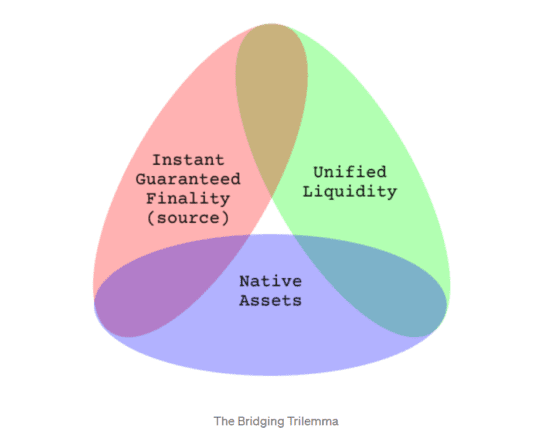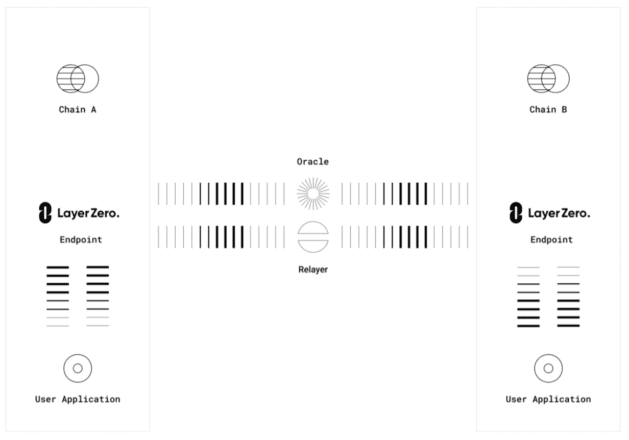DeFi Project Spotlight: Stargate, Cross-Chain Liquidity Reimagined
Stargate is a fully composable cross-chain liquidity transport infrastructure built over the first trustless omni-chain interoperability protocol, LayerZero.

Key Takeaways
- Stargate is the first fully composable cross-chain liquidity transfer protocol for native assets with unified liquidity and instant guaranteed finality.
- Stargate is built over LayerZero, a novel trustless cross-chain messaging protocol that lets smart contracts and decentralized applications living on different blockchains communicate with one another.
- Stargate is built as an open and composable piece of blockchain infrastructure that could be leveraged by other decentralized applications and projects aiming to go multi-chain.
Share this article
Stargate is a fully composable cross-chain primitive that enables native asset transfers between blockchain networks with instantly guaranteed finality. It is built on top of LayerZero, a novel piece of omni-chain infrastructure that lets decentralized applications on different blockchains communicate safely and efficiently.
The State of Play in Cross-Chain Liquidity
Stargate is a cross-chain liquidity transfer protocol that lets users and decentralized applications transfer native assets between chains in a capital-efficient manner with instantly guaranteed finality.
To understand Stargate’s value proposition as a novel bridging solution, it’s first necessary to explain how cross-chain liquidity and asset transfers currently work in crypto. Today, users looking to make cross-chain asset swaps have two main options: off-chain, through centralized exchanges, which introduce regulatory, counterparty, and privacy risks, or on-chain, through pieces of blockchain infrastructure called bridges.
Blockchain bridges fall under two broad categories: the first type relies on a consensus-forming middle chain to validate and relay messages across blockchain networks, and the second type runs on an on-chain light node. The downside of the former approach is that it creates a single point of failure, risking the liquidity on all chains in the event of a hack or consensus corruption. It also requires destination chains to trust the middle chain, which itself is never fully decentralized as it is usually a permissioned chain with a minimal set of validators or is secured by a multi-sig. While the latter approach is secure, it’s also expensive, often costing tens of millions of dollars per day per an Ethereum-attached chain.
Bridging or transferring assets cross-chain is also especially difficult because of the inherent incompatibility between blockchains. If a specific token isn’t natively minted or supported on both chains, bridging it from one chain to another requires using a “wrapped” or intermediary synthetic asset. Functionally, this means locking up the native token into a smart contract on the source chain and then minting a synthetic or a wrapped version of the asset (for example, ETH to wETH) on the destination chain.
This approach introduces a perpetual risk for users holding wrapped assets. After all, the smart contract custodying the native assets on the source chain could get hacked and drained of its funds, effectively making the wrapped tokens worthless because users can no longer swap them back for the authentic native assets. This is precisely what happened with the Ronin bridge hack in March when a North Korean cybercrime syndicate stole over $550 million worth of ETH and USDC in the second-biggest hack in DeFi history. Then, the hackers compromised five validator nodes, obtained their private keys, and stole all the assets held by the bridge contract, leaving all wrapped ETH on Axie Infinity’s Ronin Network worthless.

The difficulty in designing blockchain bridges stems partly from the so-called “Bridging Trilemma,” a theory that states that developers must compromise between securing unified liquidity, instant guaranteed finality, and native asset swaps. Unified liquidity offers shared access to a single liquidity pool between multiple chains, dramatically improving cross-chain capital efficiency. Instantly guaranteed finality means that applications on the destination chain know that a committed transaction will settle at the source chain, solving the problem of transactions reverting due to a lack of liquidity at the destination chain. Finally, native asset swap functionality means that the bridge doesn’t rely on insecure synthetic or wrapped assets.
Where most bridges today sacrifice native asset swaps in favor of wrapped ones, LayerZero Labs, the team behind Stargate, says it has solved the Bridging Trilemma by building a composable bridging infrastructure that allows for native asset swaps without sacrificing instant guaranteed finality.
Stargate Explained
Stargate is a novel, composable cross-chain bridge built as the first decentralized application over the trustless omni-chain interoperability protocol, LayerZero. It is a user application-configurable omni-chain messaging system that runs an ultra-light node to provide the security of a light node with the cost-effectiveness of middle chains. In simple terms, LayerZero has created a cross-chain messaging protocol that lets developers merge the best of both worlds in bridge design and create different multi-chain applications—including more secure and capital-efficient bridges—that support native token swaps and are easier to wrap or implement by decentralized applications.
LayerZero Labs has invented a novel resource-balancing algorithm dubbed “the Delta Algorithm” that leverages unified cross-chain liquidity to enable a new class of cross-chain bridge dealing purely in native assets. Crypto Briefing connected with LayerZero Labs co-founder and Chief Technology Officer Ryan Zarick to learn more about Stargate, and he started by discussing how the team was inspired to launch the project. He said:
“Instead of leaving it to third-party developers to build the first decentralized application and cross-chain bridge leveraging LayerZero, we figured we would do it ourselves. Stargate, like LayerZero, is envisioned to be infrastructure. We want applications like [the decentralized exchange] Sushi to build on top of Stargate and allow users to swap any asset with any other asset in a single transaction.”
The Stargate bridge currently supports swaps between three stablecoins (USDT, USDC, and BUSD) across seven different blockchain networks (Ethereum, BNB Chain, Avalanche, Polygon, Arbitrum, Optimism, and Fantom). Although it can theoretically support all crypto assets, Stargate focuses on the three biggest stablecoins because they are natively available on all supported chains and because moving stable assets is significantly safer than moving cross-chain. “We wanted to stay away from wrapped assets,” Zarick said, explaining that the team thinks they carry added risk. “Every dollar you wrap on another chain carries a risk that that asset will be de-pegged or lost because somebody can steal the funds locked on the source chain, and now you’re stranded with this asset that’s worth zero.”
Stargate’s Novel Features
Besides native asset swaps and composability, Stargate’s most powerful feature might be its capital-efficient, unified liquidity pools shared across chains. The unified liquidity feature is very significant. For context, to swap USDT from Ethereum to USDC on Polygon, Stargate users deposit USDT in the single USDT liquidity pool on Ethereum and automatically receive USDC from the single USDC liquidity on Polygon. The Delta Algorithm seamlessly rebalances both pools across chains in the background so that the deposited and withdrawn amounts are always equal. The critical thing here is that, instead of each of the seven supported chains maintaining a separate liquidity pool per a cross-chain connection for each asset, Stargate has a single, unified-liquidity pool per asset for all connections. Zarick explained this point in detail:
“Instead of having, for example, one USDC pool on Ethereum connected only to Avalanche; you can have a pool for a single asset on one chain connected to pools of the same asset on all other chains. This allows liquidity providers to accumulate fees from people moving assets on their chain from seven or more different chains rather than a single one. This means more fees, which means deeper liquidity, which attracts more users and spins the whole flywheel again.”
As Stargate scales by adding more native assets and blockchain network connections, it will have significantly fewer liquidity pools accruing fees from ever-more cross-chain links instead of having ever-more liquidity pools accruing fewer fees from a single connection like regular bridges.
On top of that, Stargate is the first and, so far, the only cross-chain composable bridge on the market, meaning that the cross-chain transfers can be composed with both the smart contracts on the source and the destination chain. This provides an unprecedented level of convenience for developers and opens up new opportunities for cross-chain applications.
As previously mentioned, Stargate is not necessarily envisioned to be a user-facing application but a piece of blockchain infrastructure other decentralized applications could wrap and leverage. For example, Sushi’s Stargate integration will let users swap between any different token across any supported blockchain as long as there’s liquidity for the token on Sushi’s decentralized exchange on the destination chain. Zarick elaborated on Sushi’s Stargate integration:
“Sushi exists on all these chains, but it’s not connected. So when I want to go between two different chains using Sushi, I have to leave the dApp and use another bridge. Well, now Sushi is going to have this interface where users could just go and say, ‘I have this asset on this chain and want that asset on that chain,’ click swap, wait a couple of minutes for the transaction to settle, and that’s it.”
Meanwhile, the Reunit omni-chain wallet, which unifies the available balance across all networks, has wrapped Stargate to allow stablecoin swaps across multiple blockchains within a single transaction. For instance, a user could swap USDC on Ethereum for USDT on Avalanche and BUSD on BNB Chain in a single, almost instantaneous transaction. And if they don’t have the native assets to pay for gas on the destination chain, Stargate’s cross-chain composability solves that. “A nice cool feature we do,” Zarick says, “is we allow you to add or buy a native token on the destination chain with your LayerZero message. So when you send, for example, USDC to Avalanche, within the single transaction you can simultaneously purchase a small amount of AVAX so when you land there you have gas money and can actually use your funds.”
Finally, perhaps the last important feature that sets Stargate apart from other bridges is its degree of security. Stargate employs a novel security concept inspired by the 2002 movie Minority Report dubbed “pre-crime.” First, by breaking the responsibilities between two different parties, the Oracle and the Relayer, the LayerZero protocol that underpins Stargate leverages the security of established oracle service providers like Chainlink or Band, with the additional security layer via the relayer system.

Because LayerZero is an open protocol, dApps building on it can choose their combination of oracles and relayers or run their own relayer, taking security into their own hands. This means Stargate can set its own assertions for the messages that get delivered by LayerZero and the ones that don’t. Zarick explained this point, referencing the main cause of the various bridge hacks that have occurred in the past:
“One of the major problems with bridge hacks is that it’s almost never the consensus mechanism but the smart contracts that get exploited. So someone exploits the endpoint smart contracts and then sends a message to another chain and steals the money. But who delivers the final blow? It’s actually that middle chain—it delivers the death blow because it doesn’t look at the message.”
To patch this security issue, LayerZero Labs came up with the concept of pre-crime. In Stargate’s case, it asserts that the books between the different interacting liquidity pools on different chains must be balanced. In other words, when someone puts $50 on one chain and tries to take out more than $50 on another chain by exploiting the smart contract, LayerZero simply won’t deliver the message. This makes it much harder to exploit the protocol.
Final Thoughts
LayerZero and Stargate have solved several critical problems that could revolutionize blockchain bridging and propel the multi-chain world into a new era of interoperability. Until recently, cross-chain liquidity was generally suboptimal from both a security and a user-experience perspective. Stargate makes it fast, secure, and efficient.
Stargate’s ultimate goal, Zarick told Crypto Briefing, is for users to be able to interact with the protocol without even realizing they’re using it. He said that he wants to see Stargate integrate into the back end of many decentralized applications, including cross-chain wallets, decentralized exchanges, yield aggregators, blockchain games, and NFT projects. In short, the aim is to make seamless any-to-any blockchain and any-to-any asset swaps a reality. Stargate has already executed on building the protocol; whether it will see traction with developers and users remains to be seen.
Disclosure: At the time of writing, the author of this piece owned ETH, STG, and several other cryptocurrencies.
Share this article
